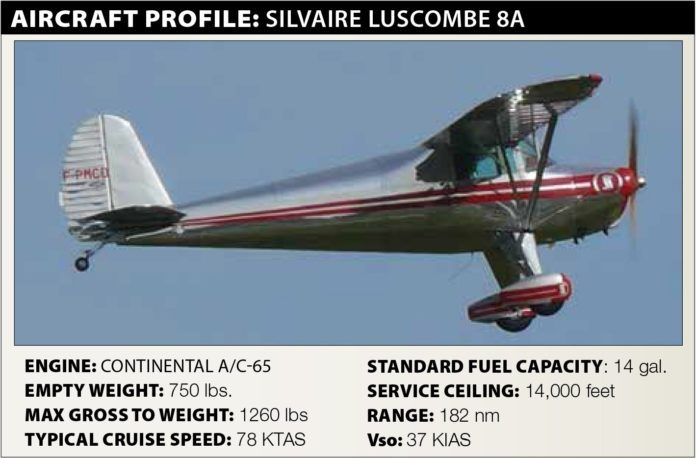A lot of ink and pixels have been spilled over the years about turning back to the departure runway if a single’s engine quits right after takeoff. The maneuver is usually referred to as a turnback, and was the topic of our January 2006 article, “Turnbacks Reconsidered”.
In it, Rich Stowell related the results of a simulator-based study of 20 pilots flying scenarios calling for engine failure shortly after takeoff. Successfully handing the emergency meant, among other parameters, the rate of descent at touchdown could not exceed 500 fpm, and bank angle had to be within five degrees of wings-level below 100 feet agl.
The study looked at the feasibility of successfully executing a turnback following an engine failure at 500 feet agl. Each pilot got seven sorties. For the first three sorties, the pilots were told to handle the emergency any way they deemed appropriate. The turnback success rate was 43 percent; the straight-ahead success rate was 100 percent.
The pilots were then required to turn back on the next four sorties and were given detailed instructions on how to perform the turns. Sorties four and seven required coordinated turns at 45 and 30 degrees of bank, respectively, at speeds slightly faster than the corresponding banked stall speeds. Sorties five and six required turns of 45 and 15 degrees of bank, flying slightly faster than the corresponding banked stall speeds, but with the application of full rudder in the direction of turn throughout. The combined success rate for sorties five and six was 50 percent. The combined success rate for sorties four and seven was 80 percent.
The study—plus additional computer modeling cited in the article—clearly show such an emergency is more survivable when pilots maintained control and landed straight ahead.
Background
On September 7, 2015, at 0958 Pacific time, a Silvaire Luscombe 8A was destroyed when it impacted terrain shortly after takeoff. The commercial pilot and private pilot-rated passenger were fatally injured. Visual conditions prevailed.
One witness heard a radio transmission over the airport’s CTAF that the airplane was experiencing a fire and returning to the airport. Another witness, a rated pilot, stated he heard the accident airplane’s engine “lose power,” then observed the airplane enter a left turn he perceived as “an emergency 180 return to the runway.” He stated the airplane appeared to lose airspeed as its left wing “dropped abruptly” and the airplane entered a “steep” nose-down attitude as it descended to ground contact.
None of the witnesses observed any smoke or fire coming from the airplane prior to impact. Despite the pilot’s report of a fire, there were no mechanical malfunctions or anomalies found with the airplane or engine, and the investigation was unable to determine the source of the in-flight fire, if any. The accident flight was the first one after the airplane’s annual inspection.
Investigation

The airplane remained largely intact but was almost entirely consumed by a post-crash fire. The soot observed on the fuselage and empennage did not display any streaking patterns. Continuity was confirmed from all flight controls to the cockpit area. The fuel selector was found in the “on” position. The single fuel tank was ejected from the airplane on impact, and contained a small amount of fuel. No reliable information could be obtained from the cockpit instruments.
Less than one foot of each propeller blade remained at the hub, which was still attached to the engine. The cylinders remained attached and relatively undamaged, with the exception of the #4 cylinder, which displayed a radial fracture stemming from the inboard and outboard sides of the induction and exhaust ports, and extended around the cylinder head to the spark plug seat.
The #4 cylinder was analyzed by the NTSB Materials Laboratory. Examination revealed the cast aluminum head portion contained multiple cracks. Detailed microscopic examination of the exposed fracture faces of the cast head portion revealed rough and coarse grain texture features consistent with overstress separation. The fracture faces showed no evidence of fatigue cracking. In other words, damage to the cylinder occurred at impact.
Probable Cause
The NTSB determined the probable cause(s) of this accident to include: “The pilot’s decision to return to the runway shortly after takeoff, and his failure to maintain adequate airspeed during the turn, which resulted in the airplane exceeding its critical angle-of-attack and experiencing an aerodynamic stall and spin.”
In some ways, this is a weird one. Although the airplane was just out of its annual inspection—always a question mark—investigators couldn’t find anything wrong with the airframe or engine that justified an emergency return to the departure runway.
Although the pilot reported an in-flight fire, there was no evidence of it. It’s certainly possible such evidence was consumed, along with most of the airframe. According to the NTSB, “Despite the pilot’s report of a fire, there were no mechanical malfunctions or anomalies found with the airplane or engine, and the investigation was unable to determine the source of the in-flight fire, if any.”
Also according to the NTSB, “The terrain in front of the airplane as it departed the airport was mainly open, flat farm fields; such an area would be favorable for a straight-ahead, forced landing. Although the pilot perceived some anomaly during takeoff that prompted him to initiate a forced landing, the airplane did not have sufficient altitude to complete the 180-degree turn back to the runway. The pilot failed to maintain sufficient airspeed, which resulted in the airplane exceeding its critical angle-of-attack and subsequently entering an aerodynamic stall and spin during the attempted turn.”
I’m convinced a pilot’s desire to turn back to the departure runway has more to do with the desire to preserve the airplane than it does the occupants. Regardless, the best choice in such a situation is the one in which the pilot maintains control until the airplane comes to a stop. Often, that means landing straight ahead.




